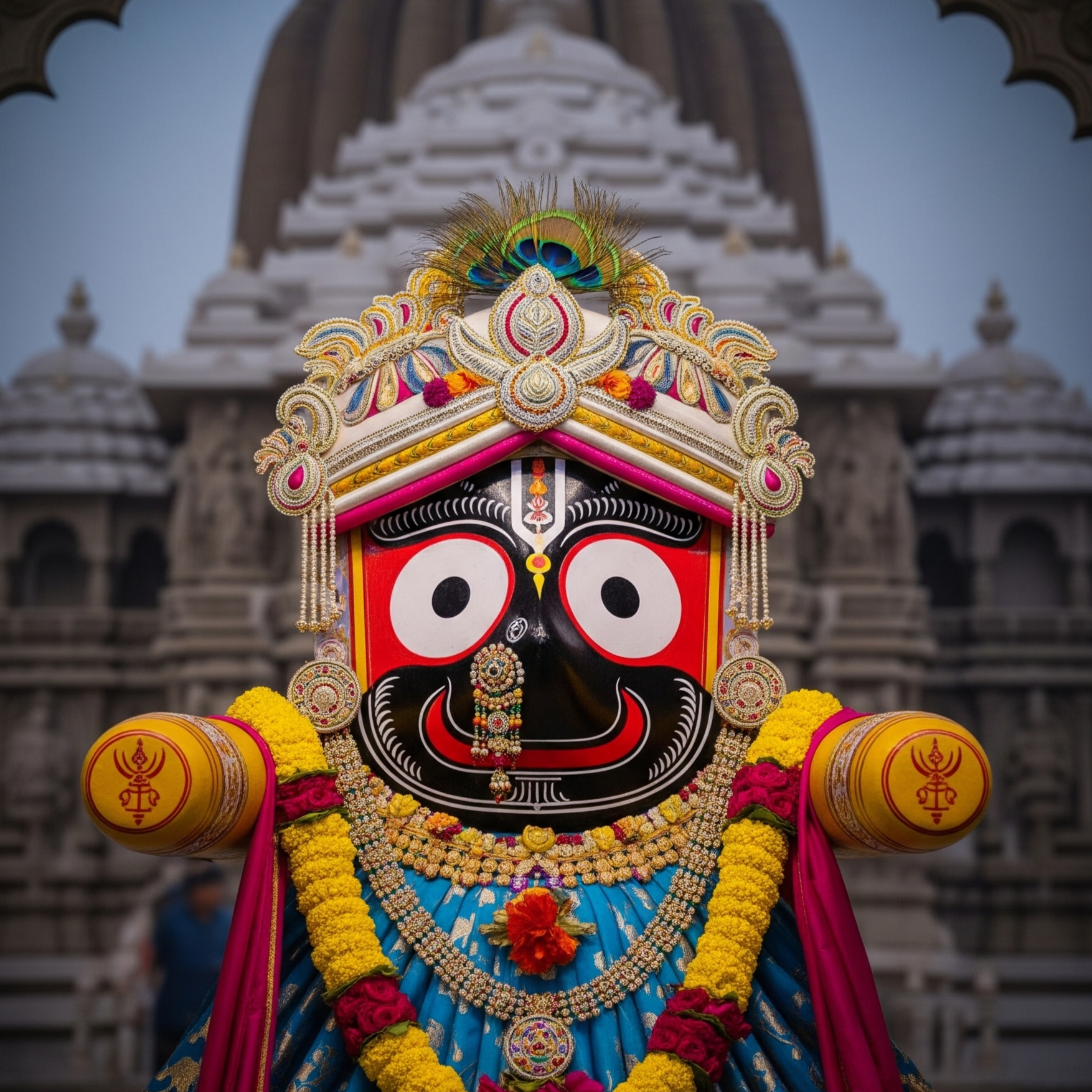Lord Jagannath, the revered deity of Puri in Odisha and the central figure of the famed Jagannath Temple and Rath Yatra, is one of the most mysterious and profound manifestations of the divine in Hinduism. Unlike the conventional depictions of deities in human form and color, Lord Jagannath’s iconography is distinct—a rounded face, large eyes, no visible limbs, and most strikingly, a black-colored body.
The black color of Lord Jagannath is not a mere aesthetic choice but a profound symbol layered with spiritual meaning, historical context, and cultural synthesis. This article explores every single detail about why Lord Jagannath is black, tracing its real origin, symbolic essence, religious interpretations, and the role it plays in shaping the philosophical understanding of the divine.
The Spiritual Symbolism of Black in Hinduism
To understand why Lord Jagannath is black, one must first step into the symbolic world of Hindu philosophy, where colors are not just visual representations but carry deep metaphysical and spiritual connotations.
In many Vedic and Puranic texts:
- Black symbolizes the infinite, the formless, and the eternal.
- It represents the unmanifested Brahman—that which exists beyond perception and beyond form.
- It is also the color of Krishna, who is often described as Shyama or Krishna, meaning “the dark one.”
Thus, black is not considered negative—it is the color of the cosmic night, of mystery, and the unknown depths of divinity.
Lord Jagannath, whose name means “Lord of the Universe”, is not confined to human representation. His black color is believed to reflect his eternal, unchanging, and all-encompassing nature—an aspect of Param Brahma (Supreme Reality).
Connection with Lord Krishna
One of the most accepted interpretations of Lord Jagannath’s form is that he is non-different from Lord Krishna, the dark-skinned incarnation of Lord Vishnu. In the Jagannath cult, Krishna is worshipped in his highest transcendental form, beyond human traits, gender, or even body structure.
Krishna’s name itself stems from the Sanskrit root “Krish,” which means attraction, and “na,” which means bliss. His black or dark-blue complexion is believed to absorb all light—just like the infinite cosmos.
Therefore, Lord Jagannath being black is symbolically Krishna, yet more expansive—representing Krishna in his cosmic form (Vishwarupa), detached from anthropomorphic limits.
Legend of Krishna’s Demise and Jagannath’s Manifestation
One of the most powerful legends that connect Lord Jagannath’s black color to Lord Krishna’s death comes from the Skanda Purana, Brahma Purana, and Jagannath Mahatmya.
After Krishna’s physical demise in Dwarka, his body did not decompose like a normal human body, but instead emitted a divine energy. His remains, especially the heart, were believed to be eternally radiant and indestructible—a divine object referred to as the “Brahma Padartha” or “Brahman essence“.
This relic was carried by the waves and later retrieved by King Indradyumna of Odisha, who built the Jagannath Temple. Following divine instruction, wooden idols of Jagannath, Balabhadra, and Subhadra were carved and this divine essence was placed inside them during the sacred ritual known as Brahma Paribartan.
The dark complexion of Lord Jagannath is said to represent Krishna’s eternal body, infused with cosmic truth and transcendental blackness—not the blackness of absence but the fullness of all creation.
Connection to Tribal and Indigenous Worship
The roots of Lord Jagannath’s black form may also be traced to ancient tribal worship in Odisha, especially the Sabara tribe. Scholars believe that Jagannath worship predates classical Vaishnavism and may have originated as a tribal deity who was later integrated into the mainstream Hindu pantheon.
The Savaras (Sabaras), a forest-dwelling tribe, worshipped a wooden deity called Nilamadhaba (Blue or Dark Vishnu), believed to have been an early form of Jagannath. This deity was dark or black in appearance, and the worship was simple, animistic, and nature-oriented.
When King Indradyumna sought Nilamadhaba for state-sponsored worship, it is believed that the tribal god transformed into the more inclusive and spiritually complex form of Jagannath—but retained his original color as a mark of continuity and respect to the tribal roots.
Thus, the black color can be seen as a bridge between indigenous spirituality and classical Hinduism, unifying diverse traditions under one divine form.
Philosophical Meaning: Jagannath as Nirguna Brahma
In Indian philosophical schools, especially in Advaita Vedanta, the highest reality is referred to as Nirguna Brahma—the formless, colorless, and attribute-less absolute. However, to relate to such a concept emotionally and culturally, people have always used symbols and forms.
Lord Jagannath, in his black, featureless, and almost abstract form, is one of the closest visual representations of Nirguna Brahma in a Saguna (with attributes) framework.
His black color, large round eyes, and formless body suggest a deity who is:
- Omnipresent, seeing all without blinking
- Timeless, without age or decay
- Beyond structure, not confined to a bodily frame
This makes Lord Jagannath both accessible to the masses and profoundly philosophical, embodying the bridge between bhakti (devotion) and jnana (wisdom).
Artistic Interpretation and Cultural Identity
From an artistic point of view, the black color of Lord Jagannath adds to the visual uniqueness of his iconography. It makes his image immediately recognizable, especially during the Rath Yatra, where millions gather to have his darshan.
His black form also reflects the cultural and geographical identity of Odisha. The Jagannath tradition is not merely religious—it is cultural, political, and social, uniting people across caste, class, and linguistic divisions.
Jagannath is the People’s God—a deity with a black body, tribal origins, and universal love. His color signifies inclusivity—embracing all beings, all emotions, all realities.
Conclusion: The Black That Contains the Universe
The blackness of Lord Jagannath is not a void. It is a cosmic womb from which the universe emerges and dissolves. It symbolizes:
- The infinity of Krishna
- The depth of tribal heritage
- The mystery of Nirguna Brahma
- And the power of inclusive spirituality
In a world obsessed with definitions and appearances, Lord Jagannath’s black form challenges the limits of form itself. He is dark, not because he hides, but because he contains everything—light, shadow, sorrow, joy, time, and transcendence.
To gaze upon the black face of Lord Jagannath is to look into the soul of the universe—a reminder that God is not bound by form or color, but is present in all.


